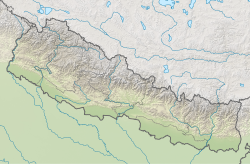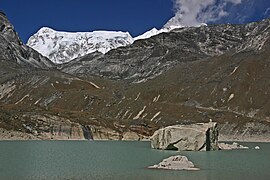Gokyo Lakes
| Gokyo Lakes | |
|---|---|
 Gokyo Lake | |
| Location | Solukhumbu District |
| Coordinates | 27°58′49″N 86°40′07″E / 27.98028°N 86.66861°E |
| Basin countries | Nepal |
| Surface area | 196.2 ha (485 acres) |
| Surface elevation | 4,700–5,000 m (15,400–16,400 ft) |
| Official name | Gokyo and associated lakes |
| Designated | 13 September 2007 |
| Reference no. | 1692[1] |
Gokyo Lakes are lakes in Nepal's Sagarmatha National Park. They are located at the height of 4,700–5,000 m (15,400–16,400 ft) above sea level. These lakes make the world's highest freshwater lake system with six main lakes. Among them Thonak Lake is the largest.[2] In September 2007, Gokyo and sorrounding wetlands of 7,770 ha (30.0 sq mi) were made into a Ramsar site.[3]
Lake system[change | change source]
Gokyo Lakes are located in Khumjung, a village of Solukhumbu District in Sagarmatha Zone in north-eastern Nepal. Gokyo Cho, also called Dudh Pokhari, is the main lake with an area of 42.9 ha (106 acres). At the eastern shore of this lake is Gokyo village. Thonak Cho is the largest lake with an area of 65.07 ha (160.8 acres). Gyazumpa Cho is 29 ha (72 acres) in size, while Tanjung Cho has an area of 16.95 ha (41.9 acres), and Ngojumba Cho has an area of 14.39 ha (35.6 acres).[4]
As sources of permanent fresh water they have high hydrological value. They get water from various sources, such as water that flows underground from the Ngozumpa glacier, a stream coming from the Renjo La pass from north-west, and another stream coming from the Ngozumpa glacier in the east. These wetlands are filled with water from many glaciers.[4]
The water from there goes to the Dudh Kosi through the Taujon Lake and the Longabanga Lake. These lakes are deeper than researchers use to believe. Fourth Lake (Thonak Cho) is the deepest lake which is 62.4 m deep. After that is the Gokyo Lake which is 43 m deep.[4] A direct connection between the Gokyo Lake and the upper Thonak Cho and the Ngozumpa Cho has not been seen. However, these lakes may be connected through an underground water supply. The Gokyo lake system is naturally at risk, as it is in an ecologically risky and unstable zone. The outburst of the Ngozumpa glacier is always a danger to the existence of the lakes.[5]
The Gokyo lake system of 19 lakes is covers an area of 196.2 ha (485 acres) and is at the hight between 4,600 and 5,100 m (15,100 and 16,700 ft). The wetland lies at the start of of the Dudh Kosi river, which flows down from Cho Oyu.[6]
Religious significance[change | change source]
The Gokyo Lakes are considered sacred by both Hindus and Buddhists. About 500 Hindus take a holy bath in the lakes during the Janai Purnima festival, which usually occurs in the month of August. On average 7,000 tourists visit the Gokyo Lakes every year.[5] The site is worshipped as the residing place of 'Nag Devata' (Snake God). A temple of the Hindu gods Vishnu and Shiva is at the western corner of the lake. The belief that birds and wildlife should not be harmed has protected the animals in this region for a long time.[2]
Tourism[change | change source]

Gokyo is among the most popular places for tourist to visit. From there, people can go towards the Sagarmatha base camp and other areas.[2] Gokyo village at 4,790 m (15,720 ft) height is a major centre in the area. The site is two days' walk uphill from Namche Bazaar.[7] A visit to the area usually includes climbing Gokyo Ri.
The Gokyo Lakes are also part of a longer Everest Base Camp trek known as the EBC trek through the Gokyo Lakes. This trek is commonly hiked by people with slightly more time to trek as the path is 4 days longer than the usual EBC trek. The Gokyo Lakes trek also has the benefit of being a circular route, unlike the usual EBC trek where people return using the same path.[8]
Gallery[change | change source]
-
Langponga Tsho, 1st Gokyo Lake
-
Taujung Tsho, 2nd Gokyo Lake
-
Dudh Pokhari, 3rd (Main) Gokyo Lake
-
Thonak Tsho, 4th Gokyo Lake
-
Ngozumpa Tsho, 5th Gokyo Lake
References[change | change source]
- ↑ "Gokyo and associated lakes". Ramsar Sites Information Service. Retrieved 25 April 2018.
- ↑ 2.0 2.1 2.2 Nepal Biodiversity Resource Book. Protected Areas, Ramsar Sites, and World Heritage Sites (PDF). Kathmandu: International Centre for Integrated Mountain Development, Ministry of Environment, Science and Technology, in cooperation with United Nations Environment Programme, Regional Office for Asia and the Pacific. 2007. ISBN 978-92-9115-033-5. Archived from the original (PDF) on 2011-07-26. Retrieved 2018-12-14.
{{cite book}}: Cite uses deprecated parameter|authors=(help) - ↑ Bhandari, B. B. (2009). Wise use of Wetlands in Nepal. Banko Janakari, Special Issue February 2009: 10–17.
- ↑ 4.0 4.1 4.2 Sharma, C. M., Sharma, S., Gurung, S., Bajracharya, R. M., Jüttner, I., Kang, S., Zhang, Q., Li, Q. (2012). First results on bathymetry and limnology of the Gokyo wetlands, high altitude tropical lakes, Nepal. Limnology 13:181–192.
- ↑ 5.0 5.1 WWF. "Terms Of Reference for Ascessing Vulnerability Of Sagarmatha National Park and Buffer Zone and Formulation Of The Community Based Adaptation Strategies" (PDF). WWF. Retrieved 2010-05-29.
- ↑ Karki, J. B., Siwakoti, M., Pradhan, N. S. (2007). "High altitude Ramsar sites in Nepal: Criteria and future ahead". The Initiation. Retrieved 2010-05-29.
{{cite web}}: CS1 maint: multiple names: authors list (link) - ↑ Wildlife Extra (2008). "Four New High Altitude Ramsar Sites Created in Nepal". Wildlife Extra, January 2008. Archived from the original on July 16, 2011.
- ↑ Hutchinson, Alex (2011-04-08). "Everest Without the Crowds". The New York Times. ISSN 0362-4331. Retrieved 2021-11-12.






